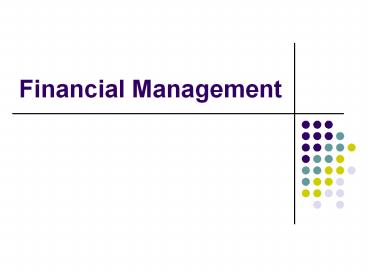Financial Management - PowerPoint PPT Presentation
Title:
Financial Management
Description:
Financial Management Financial Planning Revenue all income that a business receives over time Expenses the costs of operating a business Revenue Expenses ... – PowerPoint PPT presentation
Number of Views:78
Avg rating:3.0/5.0
Title: Financial Management
1
Financial Management
2
Financial Planning
- Revenue all income that a business receives
over time - Expenses the costs of operating a business
- Revenue Expenses Profit or Loss
3
Developing a Budget
- Budget Detailed plans for the financial needs
of individuals, families, or businesses - The most important step in financial planning is
developing a budget
4
Business Budgets
- A business budget has the following goals
- Determine the sources and amounts of income
- Identify the types of expenses and predict their
costs - Determine how income will be distributed to cover
those expenses - Reward investors if there is a profit
5
Types of Budgets
- Start-Up Budget plans income and expenses for a
new business from the beginning until it becomes
profitable - Operating Budget describes the financial plan
for ongoing operations of the business - Cash Budget estimate of the actual money
received and paid out
6
Financial Records
- Asset records name the buildings and equipment
owned by a business, their original current value
and the amount owed if the money was borrowed to
purchase the asset - Depreciation records identify the amount assets
have decreased in value due to their age and use
7
Financial Records
- Inventory records identify the type and number
of products on hand for sale - Records of accounts identify all purchases made
using credit - Accounts payable records identifies the
companies from which credit purchases were made
and the amount purchased, paid and owed
8
Financial Records
- Accounts receivable records identify customers
that made purchases using credit and the status
of each account - Cash records list all cash received and spent
- Payroll records information on all employees,
and their compensation and benefits - Tax records show all taxes collected, owed, and
paid
9
Financial Statements
- Assets what a company owns
- Liabilities what a company owes
- Owners Equity the value of the owners
investment in the business - Reports that sum up the financial performance of
a business are called financial statements.
10
Balance Sheet
- Used to report a companys assets, liabilities,
and owners equity - Usually prepared every six months or once a year
- Left side lists assets
- Two categories Current and Long-Term
- Right side lists liabilities
- Two categories Current and Long-Term
11
(No Transcript)
12
Income Statement
- Used to report the revenue, expenses, and net
income or loss from operations for a period of
time - Revenue includes all sources of income sales or
products or services, interest earned from
investments - Expenses cost of operating business rent,
supplies, inventory, payroll, utilities
13
Income Statement Income Sale of Crop
Products 50,000 Sale of Livestock
Products 25,000 Government
Payments 10,000 Total Income
85,000 Expenses Seed 10,000
Fertilizer 20,000 Feed 10,000
Processing 10,000 Marketing 5,000
Depreciation 10,000 Total
Expenses 60,000 Net Income 25,000
14
Financial Performance Ratios
Current Assets Current Liabilities
- Current Ratio
- Debt to Equity Ratio
- Return on Equity Ratio
Total Liabilities Owners Equity
Net Profit Owners Equity































